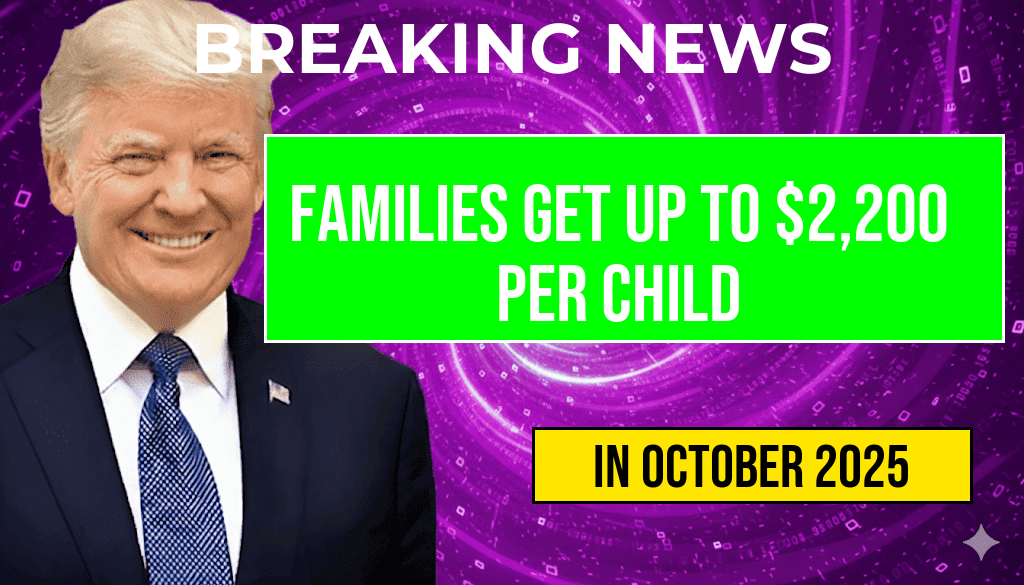Starting in 2024, families across the United States can expect a significant boost to their finances as the Child Tax Credit (CTC) returns in a more robust form. Eligible families will receive up to $2,200 for each qualifying child, providing much-needed relief amid rising living costs. This reinstatement of the expanded CTC comes after its temporary implementation during the COVID-19 pandemic, which aimed to support families facing economic hardship. Advocates for family welfare are optimistic about the financial impact this measure will have, especially for low- and middle-income households. With these funds, families will have greater flexibility to meet expenses related to childcare, education, and everyday living, thereby contributing to the overall economic stability of communities.
Details of the Child Tax Credit Reinstatement
The reinstated Child Tax Credit will offer up to $2,200 per qualifying child under the age of 17. This amount is a substantial increase from previous years, reflecting adjustments for inflation and the ongoing need to support families. The parameters for eligibility are expected to mirror those from the enhanced CTC provisions enacted during the pandemic, which allowed for larger credits and made the credit fully refundable.
Who Is Eligible?
Eligibility for the Child Tax Credit is primarily based on income and the number of dependent children. Here are the key criteria:
- Families must have a qualifying child who is under the age of 17 at the end of the tax year.
- Eligibility phases out for individuals with an adjusted gross income (AGI) above $200,000 and couples filing jointly with an AGI above $400,000.
- Children must have valid Social Security numbers to qualify for the credit.
Impact on Families and Communities
The return of the Child Tax Credit is anticipated to have a profound impact on families, particularly those with limited financial resources. The funds can be utilized in various ways, enabling families to:
- Cover essential expenses such as groceries, housing, and utilities.
- Invest in children’s education and extracurricular activities.
- Save for future needs, such as college tuition or emergency funds.
According to a report by the Forbes Advisor, the CTC is expected to lift millions of children out of poverty, providing a critical safety net for families struggling to make ends meet.
How to Claim the Child Tax Credit
Families can claim the Child Tax Credit when filing their federal income taxes. It is essential to keep accurate records of all qualifying children and relevant income details. Here are some steps to follow:
- Gather necessary documentation, including Social Security numbers for each qualifying child.
- Consult with a tax professional or use reliable tax preparation software to ensure correct filing.
- Stay informed about any changes to tax laws or eligibility requirements that may arise.
Legislative Background
The expansion of the Child Tax Credit originated from the American Rescue Plan Act of 2021, which aimed to address economic disparities exacerbated by the pandemic. The plan temporarily increased the credit amount and made it more accessible for families. As discussions continue in Congress regarding family support initiatives, the reinstatement of the CTC marks a crucial step in promoting economic equity.
Future of the Child Tax Credit
Looking ahead, lawmakers are considering permanent enhancements to the Child Tax Credit, influenced by its success in reducing child poverty rates. Advocacy groups are pushing for ongoing reforms to ensure families receive adequate support. The future of the CTC remains a significant topic in economic policy discussions, as its potential to foster financial stability for families cannot be understated.
Conclusion
The reinstatement of the Child Tax Credit in 2024 promises to provide vital financial support for millions of families. With a maximum benefit of $2,200 per qualifying child, this initiative aims to alleviate some of the financial pressures that families face today. As families prepare for its return, understanding eligibility and claiming procedures will be essential for maximizing the benefits of this important tax credit.
| Criteria | Details |
|---|---|
| Maximum Credit | $2,200 per qualifying child |
| Age Limit | Under 17 |
| Income Phase-Out | $200,000 (individuals); $400,000 (couples) |
| Social Security Requirement | Required for qualifying children |
Frequently Asked Questions
What is the Child Tax Credit and how does it work?
The Child Tax Credit is a federal tax benefit designed to support families with children. For the upcoming year, eligible families can receive up to $2,200 for each qualifying child, which helps to reduce their overall tax liability.
Who qualifies for the Child Tax Credit?
To qualify for the Child Tax Credit, families must meet certain criteria, including income limits and filing status. Generally, the credit is available to families with children under the age of 17 who are dependents on their tax return.
How will the Child Tax Credit impact my tax return?
The Child Tax Credit directly reduces the amount of tax you owe, potentially resulting in a larger tax refund or a lower tax bill. Families claiming the maximum credit can significantly benefit from this financial assistance.
When will families start receiving the Child Tax Credit for the upcoming year?
Families can expect to receive the Child Tax Credit when they file their taxes for the upcoming year. The credit can be claimed on your tax return, and any eligible amounts will be reflected in your refund or tax liability.
Is the Child Tax Credit refundable?
Yes, the Child Tax Credit is partially refundable. This means that if the credit exceeds the amount of taxes owed, families may receive the difference as a refund, enhancing the financial support for those who qualify.











